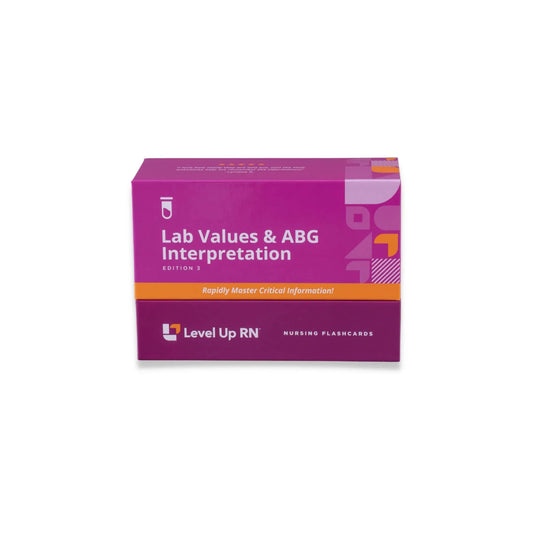In this video, Cathy goes through four example ABG Interpretation problems and answers. You can download the questions and answers below to print out and follow along. We've also explained the steps for interpretation below.
Need help interpreting ABGs? Check out our Arterial Blood Gas Interpretation Flashcards for Nursing Students.
ABG practice question 1
A patient's arterial blood gas measurements read pH = 7.29, PaCO₂ = 47 mmHg, and HCO₃ = 24 mEq/L. How would you interpret this?
Steps for interpretation
- Check the pH to determine if we have acidosis or alkalosis. The normal range for pH is 7.35 - 7.45.
- The pH here is 7.29, which is out of range on the acidic side. Therefore, we have ACIDOSIS.
- Determine which system, metabolic or respiratory, is causing the acidosis. Check the PaCO₂, which represents the respiratory system, first. The normal range for PaCO₂ is 35 - 45 mmHg.
- The PaCO₂ here is 47 mmHg, which is out of range on the acidic side.
- Therefore, the respiratory system is causing the acidosis and we have RESPIRATORY ACIDOSIS.
- Check if there is compensation. Because it's respiratory acidosis, it's the metabolic system that would be compensating. The metabolic system is represented by HCO₃. So we'll check HCO₃ to check for compensation. The normal range for HCO₃ is 22 - 26 mEq/L.
- The HCO₃ here is 24 mEq/L, which is within normal range. There is no compensation.
- Therefore, we have UNCOMPENSATED RESPIRATORY ACIDOSIS
Lab Values & ABG Interpretation - Nursing Flashcards
ABG practice question 2
A patient's arterial blood gas measurements read pH = 7.31, PaCO₂ = 49 mmHg, HCO₃ = 30 mEq/L. How would you interpret this?
Steps for interpretation
- Check the pH to determine if we have acidosis or alkalosis. The normal range for pH is 7.35 - 7.45.
- The pH here is 7.31, which is out of range on the acidic side. Therefore, we have ACIDOSIS.
- Determine which system, metabolic or respiratory, is causing the acidosis. Check the PaCO₂, which represents the respiratory system, first. The normal range for PaCO₂ is 35 - 45 mmHg.
- The PaCO₂ here is 49 mmHg, which is out of range on the acidic side.
- Therefore, the respiratory system is causing the acidosis and we have RESPIRATORY ACIDOSIS.
- Check if there is compensation. Because it's respiratory acidosis, it's the metabolic system that would be compensating. The metabolic system is represented by HCO₃. So we'll check HCO₃ to check for compensation. The normal range for HCO₃ is 22 - 26 mEq/L.
- The HCO₃ here is 30 mEq/L, which is out of range on the basic side. This means there is metabolic compensation.
- To determine if the compensation is partial or full, we check the pH again. The pH was 7.31 which is outside the normal range, so the metabolic system has not succeeded in fully compensating.
- Therefore, we have PARTIALLY COMPENSATED RESPIRATORY ACIDOSIS.
ABG practice question 3
A patient's arterial blood gas measurements read pH = 7.35, PaCO₂ = 48 mmHg, HCO₃ = 29 mEq/L. How would you interpret this?
Steps for interpretation
- Check the pH to determine if we have acidosis or alkalosis. The normal range for pH is 7.35 - 7.45.
- The pH here is 7.35, which is normal but on the acidic side. This might be acidosis.
- Determine which system, metabolic or respiratory, is causing the acidosis. Check the PaCO₂, which represents the respiratory system, first. The normal range for PaCO₂ is 35 - 45 mmHg.
- The PaCO₂ here is 48 mmHg, which is out of range on the acidic side.
- Therefore, the respiratory system is causing the acidosis and we have RESPIRATORY ACIDOSIS.
- Check if there is compensation. Because it's respiratory acidosis, it's the metabolic system that would be compensating. The metabolic system is represented by HCO₃. So we'll check HCO₃ to check for compensation. The normal range for HCO₃ is 22 - 26 mEq/L.
- The HCO₃ here is 29 mEq/L, which is out of range on the basic side. This means there is metabolic compensation.
- To determine if the compensation is partial or full, we check the pH again. The pH was 7.35, which is within the normal range, so the metabolic system has succeeded in fully compensating.
- Therefore, we have FULLY COMPENSATED RESPIRATORY ACIDOSIS.
ABG practice question 4
A patient's arterial blood gas measurements read pH = 7.49, PaCO₂ = 33 mmHg, HCO₃ = 24 mEq/L. How would you interpret this?
Steps for interpretation
- Check the pH to determine if we have acidosis or alkalosis. The normal range for pH is 7.35 - 7.45.
- The pH here is 7.49, which is out of range on the basic side. So we have ALKALOSIS.
- Determine which system, metabolic or respiratory, is causing the alkalosis. Check the PaCO₂, which represents the respiratory system, first. The normal range for PaCO₂ is 35 - 45 mmHg.
- The PaCO₂ here is 33 mmHg, which is out of range on the basic side.
- Therefore, the respiratory system is causing the alkalosis and we have RESPIRATORY ALKALOSIS.
- Check if there is compensation. Because it's respiratory alkalosis, it's the metabolic system that would be compensating. The metabolic system is represented by HCO₃. So we'll check HCO₃ to check for compensation. The normal range for HCO₃ is 22 - 26 mEq/L.
- The HCO₃ here is 24 mEq/L, which is within the normal range. There is no compensation.
- Therefore, we have UNCOMPENSATED RESPIRATORY ALKALOSIS.



4 comments
Well simplified. Thank you
I’m still struggling whether an ABG is compensated, uncompensated, or partially compensated.
This is so helpful, no need to know which arrow is moving in the same direction or opposite direction. Thank you.
I struggle with whether an ABG is compensated, uncompensated, or partially compensated. The interpretations here really helped. Thank you!